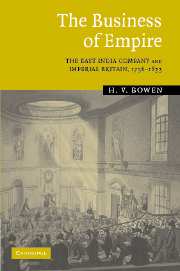Book contents
- Frontmatter
- Contents
- List of figures
- List of tables
- Preface
- Notes on the text
- List of abbreviations and short titles
- 1 Introduction
- 2 Relationships: city, state, and empire
- 3 Relationships: government and the Company
- 4 People: investors in empire
- 5 People: Company men
- 6 Methods: an empire in writing
- 7 Methods: the government of empire
- 8 Methods: the management of trade
- 9 Influences: the Company and the British economy
- Afterword
- Index
8 - Methods: the management of trade
Published online by Cambridge University Press: 09 July 2009
- Frontmatter
- Contents
- List of figures
- List of tables
- Preface
- Notes on the text
- List of abbreviations and short titles
- 1 Introduction
- 2 Relationships: city, state, and empire
- 3 Relationships: government and the Company
- 4 People: investors in empire
- 5 People: Company men
- 6 Methods: an empire in writing
- 7 Methods: the government of empire
- 8 Methods: the management of trade
- 9 Influences: the Company and the British economy
- Afterword
- Index
Summary
During the late eighteenth century the directors of the East India Company were obliged to devote ever greater amounts of time and attention to the problems of empire, but they could ill-afford to neglect their supervision of the Company's commercial affairs. It was very much a case of business as usual and commodities were procured, cargoes assembled, and ships despatched in time-honoured fashion. The management of the Company's trade was, however, far from unaffected by the acquisition of empire because events in Bengal during the 1760s caused the whole nature and purpose of the East India trade to be altered as an attempt was made to secure the transfer of ‘tribute’ from India to Britain. In 1765, as a parliamentary committee later put it, ‘a very great revolution took place in commerce as well as dominion’ and a ‘new way of supplying the market of Europe, by means of British power and influence was invented’. This commercial ‘revolution’ – the ploughing of revenue surplus into enlarged investment in commodities for shipment to Britain – was far from successful, however, and when the Company was plunged into a series of deep financial crises during the 1770s and 1780s the directors were held to have squandered a glorious opportunity to strengthen the nation's wealth and prosperity. At the same time, they were blamed for a failure to expand exports and there was a growing clamour of opposition to the Company from the supporters of free trade who believed that private merchants were better equipped to exploit markets in Asia.
- Type
- Chapter
- Information
- The Business of EmpireThe East India Company and Imperial Britain, 1756–1833, pp. 219 - 259Publisher: Cambridge University PressPrint publication year: 2005

